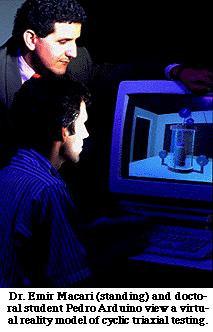
![]()
| Bulletin Board: Articles | go back to the bulletin board |
| Lessening
the Earthquake Risk: Georgia Tech Research Blends Many Disciplines to Find Needed Solutions |
|
| By James E. Kloeppel Photography by Stanley Leary |
 |
Because
of Emir Macari's birth, his family lives. Dr. Macari, a professor in Georgia Tech's School of Civil and Environmental Engineering, was born in Mexico City on July 22, 1957, six days before a major earthquake rocked the city. His family had planned on moving into a larger apartment complex, but delayed their move because the baby was late in arriving. "It was a good thing, too," says Macari. "The building we were to move into collapsed during the earthquake. We all could have been killed." Now, Macari wants to help protect the lives of others living in earthquake-prone areas. He is not alone in his quest. Across the Tech campus, civil engineers, |
number of programs ranging from earthquake prediction and earthquake
engineering to risk assessment and damage mitigation.
The programs are diverse, but the goals remain the same: to lessen the
risk posed by major earthquakes.
Earthquake Hazards Mapping
Major earthquakes seem to be occurring with more frightening regularity,
says Macari ,and they are causing much more damage and loss of life
than in the past. A recent quake in Russia, for example, caused billions
of dollars in property damage and claimed 2,000 lives. The earthquake
that struck Kobe, Japan, early this year, killed more than 5,000,
injured more than 26,000, and left some 300,000 homeless.
Damage estimates topped $200 billion.
"We can't stop earthquakes from occurring," says Macari, "but we can come
up with effective ways of reducing the risk and mitigating the damage. "
Common geotechnical hazards that occur during earthquakes include soil
liquefaction, ground motion amplification and landslides," says Macari.
"Soil liquefaction occurs when water-saturated, sandy soil is shaken
during an earthquake. The intense vibrations disrupt the normal
character of the soil, transforming it from a solid to a fluid state.
In essence, liquefaction turns the ground into quicksand, causing
building foundations lose their footing and sink."
Ground amplification occurs when the surrounding soil goes into resonance,
thereby magnifying the intensity of earthquake-induced vibrations. Mexico
City offers a classic example.
"Mexico City was buiit on top of an old lake bed," says Macari. "The
underlying sediments can be compared to a huge bowl of gelatin. When
you shake this 'bowl' at the bottom, the lake bed can resonate, substantially
increasing the vibrational amplitude at the surface. So even a small
earthquake can have devastating consequences to the buildings located above."
This article was published in Research Horizons at Georgia Tech
on May 8, 1996: http://www.gtri.gatech.edu/rh-sf95/quake.htm
home | members | institutions | include me | bulletin board | search | order | feedback | links | sitemap | contact us
Sponsored by the MIT Provost's Office
Last updated on 06/28/2000 by www-deanofcollege@vassar.edu
